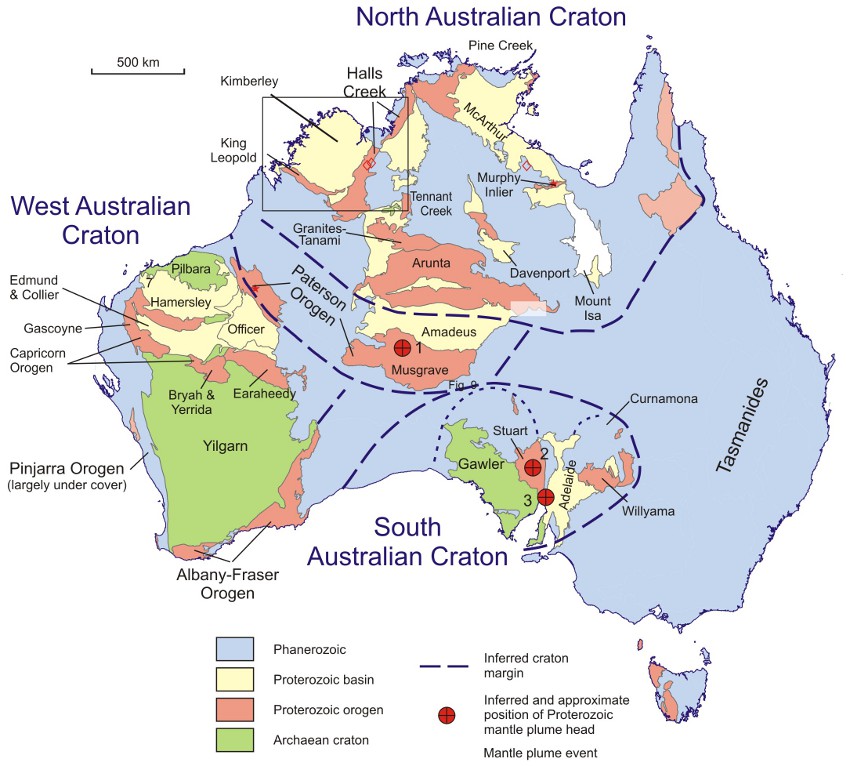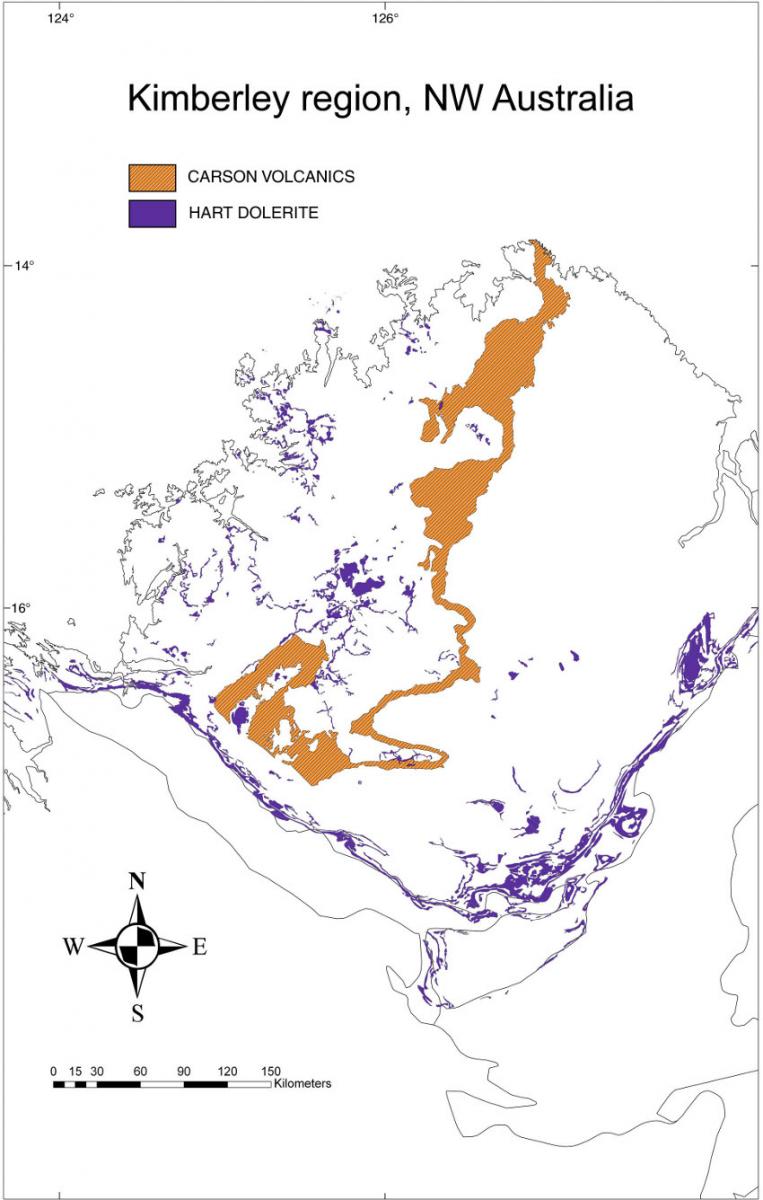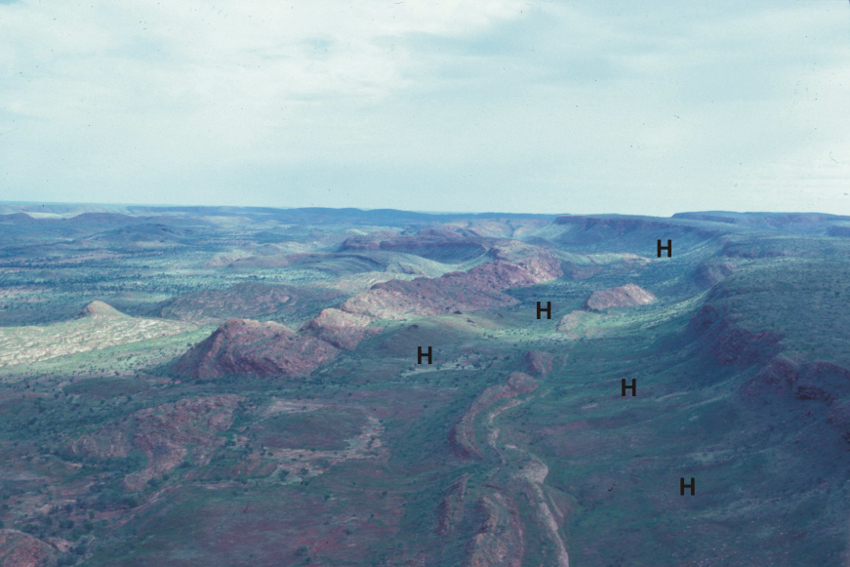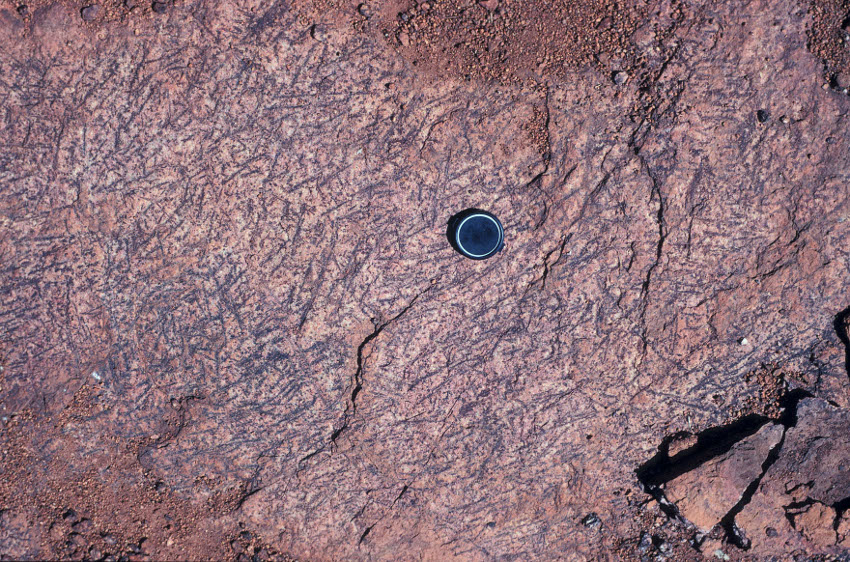August 2006 LIP of the Month
Corresponds to event No. 143 in LIP record database.
Hart-Carson LIP, Kimberley region, northern Western Australia
Ian M. Tyler, Steve Sheppard, Franco Pirajno, and Tim J. Griffin
Geological Survey of Western Australia, 100 Plain Street, East Perth 6004, Australia
Introduction
In northern Western Australia Palaeoproterozoic sedimentary successions of the Speewah and Kimberley Basins unconformably overlie the Kimberley Craton, cover an area of about 160 000 km2 and have an aggregate thickness of about 5000 m (Fig. 1; Griffin and Grey 1990). Mafic igneous rocks in the Kimberley and Speewah Basins are represented by the Carson Volcanics (<1835 Ma and >1790 Ma) and Hart Dolerite (c. 1790 Ma) (Griffin et al., 1993). The vast extent of these mafic rocks, probably in excess of 100 000 km2, and with an estimated total volume of 250 000 km3, constitute a large igneous province (LIP; event No. 143 of Ernst and Buchan 2001).

Figure 1: Simplified geology of Australia; the Kimberley Province is shown in the rectangle (see also Fig. 2); red circles indicate possible position of Proterozoic mantle plume heads (1 = 1.07 Ga Warakurna; 2) 1.58 Ga Hitalba-Gawler Range; 3) 0.83 Ga Gairdner. After Pirajno and Bagas, submitted to Precambrian Research.
Regional geology
The Speewah Group unconformably overlies Paleoproterozoic igneous and metamorphic rocks in the Halls Creek and King Leopold Orogens. The group is exposed only along the upturned margins of the orogens, being elsewhere blanketed by the Kimberley Group. The Speewah Group is about 1000 m thick and comprises a dominantly fluvial succession of quartz sandstone and feldspathic sandstone, interbedded with mudstone and minor felsic volcanic rocks. Palaeocurrent data from the Speewah Group suggest that sediment was derived from the elevated and tectonically active Halls Creek Orogen to the east and northeast, and transported along a fault-bounded northeast-trending trough (Gellatly et al., 1975). Felsic volcanic rocks from the base of the upper part of the group give a SHRIMP U-Pb zircon age of 1834 ± 3 Ma (Page and Sun, 1994). This age is coincident with the onset of deformation and magmatism in the Halls Creek Orogen to the east.
The Kimberley Group is about 4000 m thick and unconformably overlies the Speewah Group or, locally, Paleoproterozoic rocks in the Halls Creek Orogen. It contains mature sandstone and siltstone, intercalated with the Carson Volcanics, discussed below. The Kimberley Group has been interpreted as having been deposited in a broad, semi-enclosed shallow marine basin, with palaeocurrent measurements suggesting a supply of sediment from the north and north-northwest (Gellatly et al., 1970).
Hart-Carson LIP
The distribution of Carson Volcanics and Hart Dolerite in the Kimberley region is shown in Fig. 2. The geology of the rocks that make up the Hart-Carson LIP is not known in detail. Geophysical data (magnetic and gravity) suggest that the Hart Dolerite and Carson Volcanics underlie parts of the Joseph Bonaparte Gulf to the northeast (Gunn and Meixner, 1998). Possibly equivalent rocks extend across the Halls Creek Orogen forming the Revolver Creek, Red Rock and Texas Downs Formations (e.g. Blake et al., 2000). Computer modelling of regional aeromagnetic data by Meixner and Gunn (1997) indicates the possible presence of vertical cylindrical feeder systems in the northeastern part of the Kimberley Basin and offshore in the vicinity of an exploration oil well (Cambridge 1).

Figure 2: Distribution of Hart Dolerite and Carson Volcanics in the Kimberley province of Western Australia.
Carson Volcanics
The Carson Volcanics outcrop throughout the lower part of the Kimberley Basin and are associated with volcaniclastic and sedimentary rocks. The Carson Volcanics typically are 400-700 m thick, but are over 1100 m thick at their exposed western end and thin irregularly to the northeast. The volcanic rocks consist mainly of tholeiitic basalt. Lava flows include pillowed and amygdaloidal basalts with subordinate pyroclastic rocks and are interlayered with sandstone, siltstone and chert units. Individual flows have thicknesses ranging from 6 m to more than 100 m. The pyroclastic materials are in places very coarse, with xenolith blocks and basaltic bombs from 10 cm to 25 cm across, suggesting proximity to eruption centres (Tyler and Griffin, 1993). The Carson Volcanics locally have disseminated pyrite and chalcopyrite (Griffin et al. 1993). Eruption of the Carson Volcanics was followed by deposition of sandstone and siltstone of the upper Kimberley Basin.
Hart Dolerite
The Hart Dolerite (Fig. 3) consists of a number of sills, with a combined thickness of 3000 m, (Griffin et al., 1993). These intruded already lithified sedimentary rocks of the Speewah and Kimberley Groups. Although a Rb-Sr isochron age of 1762 ± 15 Ma was reported by Page et al. (1984), a more robust estimate of the age of igneous intrusion is given by a SHRIMP U-Pb zircon age of 1790 ± 4 Ma (R. W. Page, unpublished data, GA sample 87598003) that can be found in the Geoscience Australia (GA) OZCHRON database (<http://www.ga.gov.au/oracle/ozchron/frames.html>).

Figure 3: Hart Dolerite (H) exposed in low lying areas, cross-cutting stratigraphy in the Kimberley Basin; rocks in the centre are rafts of sedimentary rocks enclosed by the Dolerite
The sills are typically tholeiitic and several are associated with thick (up to 250 m) granophyric tops (Griffin and Grey, 1990). The main basic rock types are dolerite, quartz dolerite, and olivine dolerite, with minor diorite and granophyric dolerite. The presence of sharp internal contacts between these rock types in some sills indicates that thicker sills are probably composite bodies (Fig. 4; Thorne et al., 1999). The granophyre (Fig. 5) largely consists of monzogranite or syenogranite, but it may include minor quartz monzonite or quartz syenite. The granophyre is mostly a medium-grained rock comprising pyroxene and plagioclase in a granophyric or micrographic matrix. Pegmatitic granophyre, comprising intergrowths of pyroxene, altered amphibole and plagioclase, is a minor component (Griffin et al., 1993; Thorne et al., 1999).

Figure 4: Subhorizontal contact between two phases of Hart Dolerite; coarser-grained at bottom; finer-grained at top

Figure 5: Hart Dolerite granophyre
The granophyre is unlikely to be related to the dolerite by crystal fractionation in situ for three reasons. First, although there is a range of rock types from olivine dolerite to felsic granophyre, transitional rock types between dolerite and granophyre are a very minor component of the unit (Gellatly et al., 1975). Second, contacts between dolerite and granophyre bodies also appear to be sharp (Thorne et al., 1999). Third, the presence of altered dolerite inclusions in the granophyre (Alvin, 1993) and granophyre dykes intruding dolerite (Gellatly et al., 1975) indicate that the granophyre is a separate intrusive body to the dolerite.
Discussion
Tyler et al. (1998) suggested that the generation of these large volume mafic melts could be related to a mantle plume and continental breakup, with the plume head located somewhere north of the present-day position of the Kimberley province. However the available geochemistry for the units (Sheppard et al., 1997) does not require a plume. It is also unclear as to precisely what time gap there is between eruption of the Carson Volcanics and intrusion of the Hart Dolerite, and the age range of the Hart Dolerite itself.
Despite the suggestion of Li et al. (1996) that the Speewah and Kimberley basins may have once linked with the Tarim Block in northwest China, it is not clear how a plume model fits with recent advances in the understanding of the tectonic evolution of the North Australian Craton (e.g. Lyons and Huston, 2006). The Kimberley Group was deposited in a shallow marine basin about 20 m.y. after the postulated collision of the Kimberley Craton with the North Australian Craton (Page et al., 2001). The Hart Dolerite was intruded shortly after north-directed subduction probably began under the southern margin of the North Australian Craton. The Hart-Carson LIP is coeval with intrusion of high-K I-type granites into the North Australian Craton to the southeast of the Kimberley region (Lyons and Huston, 2006). Therefore, eruption of the Carson Volcanics and subsequent intrusion of the Hart Dolerite may have been driven by changing plate boundary forces rather than a plume.
The age (1835-1790 Ma) of the Hart-Carson LIP is older than the probable age of meta-tholeiite suites in the eastern part of the Arunta Inlier (event 140; Ernst and Buchan, 2001) and the Taihang-Hengshan mafic rocks (event no.141; Ernst and Buchan 2001) in the North China Craton.
The Hart-Carson LIP may have considerable potential for orthomagmatic sulphide systems. Mineral systems that may be associated with this LIP include Noril’sk type Ni-Cu-PGE deposits (feeders and sills). Crustal contamination and sulphur saturation of the magmas are some of the key elements that are necessary for the formation of these orthomagmatic deposits. In addition, thermal energy related to the emplacement of voluminous mafic melts in the crust, leads to large scale hydrothermal circulation, which may well result in the inception of epithermal style mineralisation.
References
Alvin, M.P., 1993. The nature, depositional conditions, and source of ore fluids and solutes of the Speewah Fluorite deposit, east Kimberley region, Western Australia. University of Western Australia, BSc (Honours) thesis (unpublished).
Blake, D. H., Tyler, I. M. and Page, R. W., 2000. Regional geology of the Halls Creek Orogen. Australian Geological Survey Organisation Bulletin 246, 163–172.
Ernst, R. E., Buchan K. L., 2001. Large mafic events through time and links with mantle-plume heads. Geological Society of America, Special Paper 352, 483–576.
Gellatly, D.C., Derrick, G.M., Plumb, K.A., 1970. Proterozoic palaeo-current directions in the Kimberley region, northwestern Australia. Geological Magazine 107, 249–257.
Gellatly, D.C., Derrick, G.M., Plumb, K.A., 1975. The geology of the Lansdowne 1:250 000 Sheet Area, Western Australia. Australia Bureau of Mineral Resources, Geology and Geophysics, Report 152.
Griffin, T. J., Grey, K., 1990. Kimberley Basin. Western Australia Geological Survey Memoir 3, 293–304.
Griffin, T. J., Tyler, I. M., Playford, P. E., 1993. Lennard River, Western Australia (3d edition). Western Australia Geological Survey, 1:250 000 Geological Series Explanatory Notes.
Gunn, P. J., Meixner, A. J. 1998. The nature of the basement to the Kimberley Blcok, northwestern Australia. Exploration Geolphysics 29, 506–511.
Li, Z-X., Zhang, L. and Powell, McA, C. 1996, Positions of the East Asian cratons in the Neoproterozoic supercontinent Rodinia. Australian Journal of Earth Sciences 43, 593–604.
Lyons, P. and Huston, D. L., 2006. Evolution and metallogenesis of the North Australian Craton. Geoscience Australia, Record 2006/16.
Meixner, A. J., Gunn, P. J. 1997. Three dimensional kinematic modelling of the magnetic field of the southern Joseph Bonaparte Gulf. Exploration Geophysics 28, 260–264.
Page, R.W., Griffin, T.J., Tyler, I.M., and Sheppard, S., 2001. Geochronological constraints on tectonic models for Australian Palaeoproterozoic high-K granites. Journal of the Geological Society, London 158, 535–545.
Page, R. W., McCulloch, M. T., Black, L. P., 1984. Isotopic record of major Precambrian events in Australia. Proceedings 27th International Geological Congress, Moscow, v. 5, 25–72, VNU Science Press, Amsterdam.
Page, R. W., Sun S-S, 1994. Evolution of the Kimberley region, W. A. and adjacent Proterozoic inliers – new geochronological constraints. Geological Society of Australia, Abstracts, v. 37, 332–333.
Pirajno, F. Bagas, L., submitted. A review of Australia's Proterozoic mineral systems and genetic models. Precambrian Research
Sheppard, S., Griffin, T. J. and Tyler, I. M., 1997, Compilation of whole-rock geochemical data for the King Leopold and Halls Creek Orogens. Western Australia Geological Survey, Record 1997/4 .
Thorne, A.M., Sheppard, S., Tyler, I.M., 1999. Lissadel, W.A. (2nd edition). Western Australia Geological Survey, 1:250 000 Geological Series Explanatory Notes.
Tyler, I. M., Griffin, T. J., 1993. Yampi, W.A. (2nd edn). Western Australia Geological Survey, 1:250 000 Geological Series Explanatory Notes.
Tyler, I. M., Pirajno, F., Bagas, L., Myers, J. S., Preston, W., 1998. The geology and mineral deposits of the Proterozoic in Western Australia. AGSO Journal of Geology & Geophysics 17, 223–244.